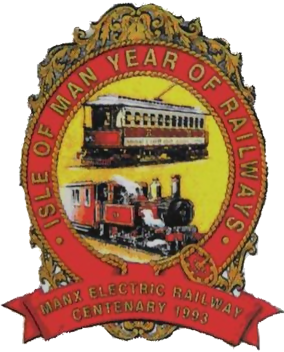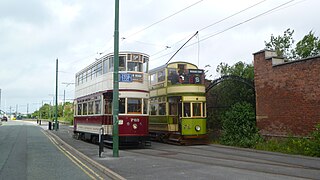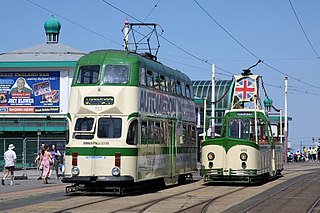
Douglas is the capital city and largest settlement of the Isle of Man, with a population of 26,677 (2021). It is located at the mouth of the River Douglas, and on a sweeping bay of two miles. The River Douglas forms part of the city's harbour and main commercial port.

The Douglas Bay Horse Tramway on the Isle of Man runs along the seafront promenade for approximately 1 mile (1.6 km), from the southern terminus at the Villa Marina, to Derby Castle station, the southern terminus of the Manx Electric Railway, where the workshops and sheds are located. It is a distinctive tourist attraction. However works have been underway to relay all of the track in 2019 and at present only a third is usable, with no published completion date for the works.

The Manx Electric Railway is an electric interurban tramway connecting Douglas, Laxey and Ramsey in the Isle of Man. It connects with the Douglas Bay Horse Tramway at its southern terminus at Derby Castle at the northern end of the promenade in Douglas, and with the Snaefell Mountain Railway at Laxey. Many visitors take an excursion on the trams. It is the oldest electric tram line in the world whose original rolling stock is still in service.

The Snaefell Mountain Railway is an electric mountain railway on the Isle of Man in Europe. It joins the village of Laxey with the summit of Snaefell, at 2,036 feet (621 m) above sea level the highest point on the island. It connects with the Manx Electric Railway (MER) in Laxey. The line is 5 miles (8 km) long, is built to 3 ft 6 in gauge and uses a Fell Incline Railway System centre rail for braking on the steep gradients. It is electrified using overhead wires at 550 volts direct current, with bow collectors.

Sheffield Tramway was an extensive tramway network serving the English city of Sheffield and its suburbs.
The Manx Northern Railway (MNR) was the second common carrier railway built in the Isle of Man. It operated as an independent concern only from 1879 to 1905.

The Year of Railways was a series of special events held on the Isle of Man during 1993 to commemorate the centenary of the opening of the first section of the Manx Electric Railway from Douglas to Groudle in September 1893.

Bungalow Station is the only intermediate station on the Isle of Man's Snaefell Mountain Railway and is located where the main mountain road intersects the line.
This page details the rolling stock on the Manx Electric Railway on the Isle of Man, which is unique insofar as the railway still operates with its original tramcars and trailers, all of which are over one hundred years old, the latest dating from 1906. Save for a fire in 1930 in which several cars and trailers were lost, all of the line's original rolling stock remains extant, though many items have been out of use for a number of years, largely due to the decrease in tourism on the island over the last thirty years. Despite this, members of each class are still represented on site today, though not all are in original form or in regular use.

Snaefell Summit railway station is the upper terminus of the Snaefell Mountain Railway on the Isle of Man and is served by the tramway of the same name.

Ramsey Station serves the town of Ramsey in the Isle of Man; it is the northern terminus of the Manx Electric Railway. It was formerly known as Ramsey (Plaza) Station after the nearby Plaza cinema, now demolished and turned into a car park. Today it is often also known as Ramsey Tram Station and signage to this effect adorns the station, despite the line being described as a railway. It should not be confused with Ramsey's former station on the Isle of Man Railway.

Southampton Corporation Tramways were in operation from 1879 to 1949. They were initially horse-drawn, but latterly powered by electricity.

Dundee Corporation Tramways formerly served the City of Dundee in Scotland. The corporation had financed the construction of a horse tramway in 1877, but had then leased it to the Dundee and District Tramways Company. They had replaced most of the horse trams with steam tram locomotives pulling trailer cars from 1884, but in 1897 the corporation decided that it would run the tramway system itself. After some negotiation and the payment of compensation, they took over the system in 1899, with a view to electrifying it. Electric trams started running in 1900, and the changeover was completed in 1902.

The Rothesay tramway was a narrow gauge electric tramway on the Isle of Bute, Scotland. It opened in 1882 as a 4 ft gauge horse tramway, was converted to a 3 ft 6 in gauge electric tramway in 1902, and closed in 1936. It was the only public tramway to be built on a Scottish island.

Derby Castle Depôt is the main location of workshops and running sheds of the Manx Electric Railway on the Isle of Man and lies at the northerly end of the promenade at Douglas; it takes its name from the adjoining site which was once home to the Earls of Derby, rulers of the island, and later extended to form an entertainment complex of the same name before being demolished and replaced by the ill-fated Summerland complex in 1968.

Wirral Tramway is a heritage tramway opened in 1995 by the Wirral Borough Council and Hamilton Quarter partnership and was operated by Blackpool Transport Services until 2005 when the council took over the licence to run the tramway.
The Jurby Transport Museum is a transport museum in Jurby on the Isle of Man occupying a former aircraft hangar.

Dundee and District Tramways operated a tramway service in Dundee between 1877 and 1899.

The Blackpool and Fleetwood Tramroad operated a tramway service between Blackpool and Fleetwood from 1898 to 1920.

Blackpool Heritage Trams are a mixed fleet of restored vehicles that run on the Blackpool Tramway, which runs from Blackpool to Fleetwood on the Fylde Coast in Lancashire, England. The line dates back to 1885 and is one of the oldest electric tramways in the world. It is operated by Blackpool Transport (BT) and is the last surviving first-generation tramway in the United Kingdom. Excluding museums, it is one of only a few tramways in the world to still use double-decker trams.

















